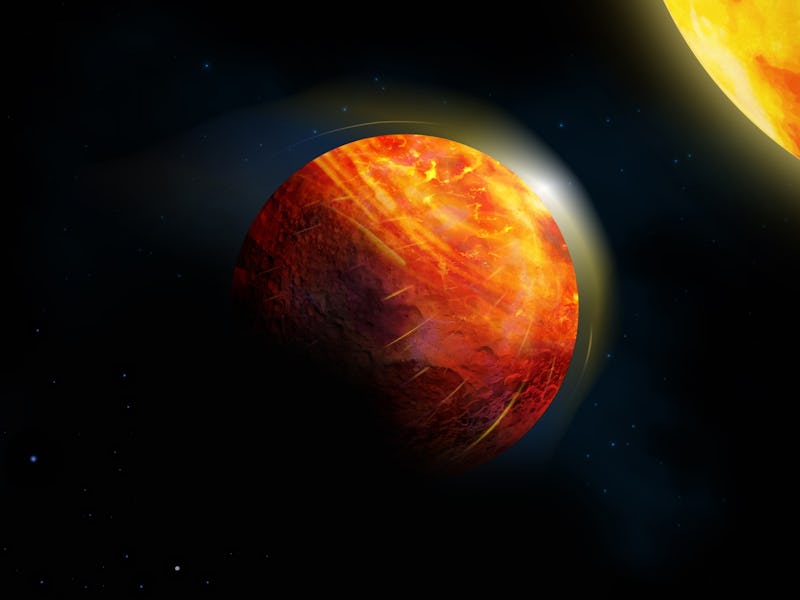Bizarre planet shows what a young Earth may have looked like
It is not pretty.

Out in the cosmos, far from our Sun's neighborhood, there are 4,000 strange and distant worlds orbiting other stars.
These exoplanets are tantalizing clues to whether there are other places in the universe life might flourish — but they also offer unprecedented insights into how our own Solar System came to be, including what our own Earth may have looked like during its younger years.
And while Earth may be breathtakingly beautiful now, a newly discovered exoplanet suggests that in its youth, or planet was a very, very different place — a strange world, with a magma ocean, supersonic winds, and vaporized rocks.
The new planet is detailed in a study published this week in the Monthly Notices of the Royal Astronomical Society.
Dubbed K2-141b, this exoplanet is located around 200 light years away from Earth. It is classified as a super-Earth, which means that it has a mass higher than that of our planet, but much lower than those of the Solar System's ice giants Uranus and Neptune, which are 14.5 and 17 times more massive than Earth.
Specifically, K2-141b is only five times more massive than the Earth.
The planet was first found in the year 2018 orbiting around a K-type, or orange dwarf, star. K2-141b's orbit is close to its host star — it takes a mere 0.3 Earth days to complete one orbit, at a distance of 0.00716 Astronomical Units. An Astronomical Unit is the distance between the center of the Earth to the center of the Sun — converted to miles, K2-141b is some 670,000 miles from its star. For context, Mercury, the closest planet to our Sun, is almost 29 million miles from the Sun.
And at that close a distance to the star, things on K2-141b can get strange, to say the least.
An illustration of the strange exoplanet, seen orbiting around a K-type star.
Weather forecasting — In this new study, the team of scientists used computer simulations to predict the weather conditions on K2-141b. What they found is unlike anything we can imagine here on Earth.
The exoplanet's surface, ocean, and atmosphere are all made up of rocks.
The exoplanet is so close to its star, it is locked in its place by the star's gravitational force. As a result, two-thirds of the exoplanet is in permanent sunlight, with temperatures reaching a scorching 3000 degrees Celsius.
Meanwhile, the temperatures on the dark side reach freezing temperatures of below -200 Celsius.
On the planet's sunny side, the temperatures are hot enough to not only melt the planet's rocky surface, but to vaporize them, creating a rock vapor atmosphere.
On Earth, water vapor rises into the atmosphere, condenses, and falls back as rain. So too on K2-141b, but instead of water, the vapor is made up of sodium, silicon monoxide, and silicon dioxide. The mineral vapor formed by the evaporated rock is then carried into freezing nightside of the exoplanet by supersonic winds, where the rocks rain back down into a magma ocean.
The currents of the ocean then flow back to the sunny side, where the rock evaporates once more. Rinse and repeat.
The planet takes only six hours to orbit its K-type star, a journey that takes Mercury 88 days.
But the scientists also predict that this cycle may shift over time. They theorize the composition of the mineral rain may slowly change over time with each cycle repetition, causing the surface and atmosphere of the exoplanet to change, too.
As strange as this exoplanet is, its weird weather and composition offers a glimpse of how our own planet began its life, too. Astronomers believe that rocky planets such as Earth started out as molten planets that eventually cooled and solidified over time.
"Lava planets give us a rare glimpse at this stage of planetary evolution,” Nicolas Cowan, a professor at the Department of Earth and Planetary Sciences at McGill University, and co-author of the new study, said in a statement.
Essentially, K2-141b may be the planetary equivalent of Earth's embarrassing baby pictures.
Abstract: Transit searches have uncovered Earth-size planets orbiting so close to their host star that their surface should be molten, so-called lava planets. We present idealized simulations of the atmosphere of lava planet K2-141b and calculate the return flow of material via circulation in the magma ocean. We then compare how pure Na, SiO, or SiO2 atmospheres would impact future observations. The more volatile Na atmosphere is thickest followed by SiO and SiO2, as expected. Despite its low vapour pressure, we find that a SiO2 atmosphere is easier to observe via transit spectroscopy due to its greater scale height near the day-night terminator and the planetary radial velocity and acceleration are very high, facilitating high dispersion spectroscopy. The special geometry that arises from very small orbits allows for a wide range of limb observations for K2-141b. After determining the magma ocean depth, we infer that the ocean circulation required for SiO steady-state flow is only 10−4 m/s while the equivalent return flow for Na is several orders of magnitude greater. This suggests that a steady-state Na atmosphere cannot be sustained and that the surface will evolve over time.
This article was originally published on